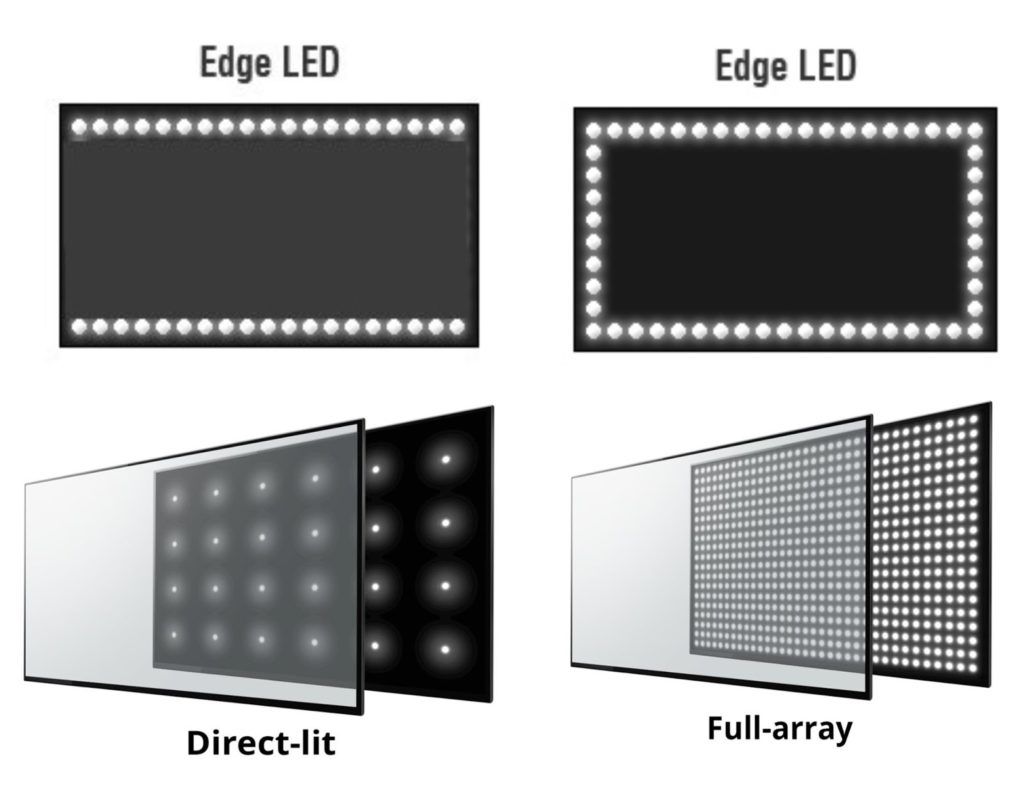A TV with LED technology, consists of an LCD LCD screen, illuminated by diodes or LED bulbs. These LEDs can be placed either on the edges or on the back of the screen. Depending on how we illuminate the screen, we will find a number of advantages and disadvantages.
Below we are going to explain, the different ways to control the lighting of an LED screen and what are the advantages and disadvantages offered by each system.
Edge LED lighting system
It is the most widely used system in LED televisions, thanks to its lower production costs, as it allows us to offer thinner designs. On Edge LED televisions, a strip of LED bulbs is generally positioned on the lower edge. The guides are used so that the light is projected all over the screen.
In this system, the local television darkening system plays an important role. When it lights up only from the bottom, it is more difficult for the TV to turn the light on and off in the necessary areas. This causes that sometimes a deep black level is not reached since it will not be able to completely extinguish that area and will let some light pass.
Therefore, the local mitigation system that television has is very important. If the light attenuation system is effective, an excellent level of contrast can be achieved.
The LED TVs on board are usually category A + or A, unlike the Full Array TVs that we will see later, which are usually energy category B and even D.
Advantages
- It allows a thin design.
- They consume less energy.
- It allows you to offer cheaper TVs.
Disadvantages
- It does not allow lighting control like the Full Array system.
- Less homogeneity.
Direct LED lighting system
The Direct LED system is currently used very little because it is usually not the best combination of image/design quality. Direct LED televisions are usually part of the input range. In these televisions, the LED bulbs are located in the back, but the number of LEDs is much lower than the Full Array televisions that we will see below. Furthermore, direct LED televisions usually do not incorporate local attenuation. This makes the screen uniformity good, but the contrast level is low.
In general, it is usually the worst option in terms of quality and design.
Advantages
- It allows for offering economic televisions.
Disadvantages
- The TV is thicker than Edge LED.
- Low contrast when not using local attenuation.
DONT MISS- QLED vs. OLED vs. MicroLED, what is the best technology?
Full Array Local Dimming Lighting System (FALD)
Full Dimming local backlight technology can be found on high-end televisions. In FALD TVs, LED bulbs are positioned in the rear as in the Direct LED. However, the number of LEDs they use is much higher in this case. This allows better illumination of the screen than previous systems.
To control lighting more precisely, they have a control panel that controls a number of blocks independently. Within each of these blocks, lighting can be adjusted to illuminate or extinguish more specific areas.
This is especially noticeable when watching movies and series where dark scenes occur. Usually, the black tones will be deeper because they will not let the light pass in that area. At the same time, the brightness level will be higher, since it will be able to illuminate bright areas to the maximum only if necessary.
The greater the number of zones, the better the lighting control and therefore the better black levels and higher brightness levels. With the new HDR content, where the brightness is greatly improved, it is an important factor to use an effective local attenuation system.
The implementation of this system usually leads to higher production costs for manufacturers, so it is reserved for higher-level televisions. Even on an aesthetic level, the thickness of the TV grows and is wider. For this reason, thin design is often required before implementing this system.
Advantages
- Superior contrast and brightness.
- Greater homogeneity on the screen.
- Reduction of possible light losses.
Disadvantages
- The thickness of the TV is greater.
- Energy consumption is higher.
- The price is usually higher.

